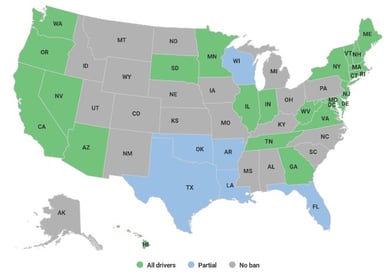We are living in extraordinary times. The COVID-19 pandemic has changed everyday tasks that we used to take for granted (like going to the grocery store) into a major obstacle. Many people have turned to online shopping with delivery or curbside pickup, to avoid standing in line at the entrance of stores, or the need to wear masks and gloves while visiting them, at risk of infections.
The increase in popularity of this way of shopping for local goods is straining our delivery infrastructure and placing additional stress on delivery drivers.
The COVID-19 pandemic has affected three areas creating “The Perfect Storm” of negative behaviors, increasing distracted driving trends.
The Perfect Storm
Three phenomena are creating the “perfect storm” for increased vehicle crashes and insurance premiums:
- Driving “quality”
- Increased distracted driving
- Driver shortages
Insurance carriers are monitoring these factors carefully, which could lead to higher premiums and changes to the coverages they offer.
Driving “Quality”
COVID-19 appears to be impacting the quality and common sense of some drivers. The demand is great for home delivery, and with that comes the increased hours and additional stress for delivery drivers. These factors can contribute to a lack of “quality,” meaning that these drivers may not be as careful as they should, take shortcuts, and ignore traffic laws.
As this lock down has forced many people to stay home, there is less traffic on the road, which is tempting some drivers to ignore speed limits or to park on the wrong side of the street to make a quick delivery.
Surprisingly, during March, there have been more crashes despite the lower number of vehicles on the road.
“Amid record low travel and vehicle miles traveled, severe and fatal crashes in cities around the United States have increased. From New York City to Austin Texas, there has been even more speeding, more deadly crashes, and more frequent severe crashes than before Covid.” -Cary Anne Nadeau, ODNsure.com
What are the causes?
Increased Distracted Driving
In addition to over-worked and stressed out drivers, driver distraction continues to be an unresolved problem. To date, most US states have partial or no bans on cell phone use while driving. As the image below depicts, the gray states have no ban, and the blue states have a partial ban.

April has traditionally been “Distracted Driving Awareness Month,” but due to the COVID-19 pandemic, it has been pushed out until October, according to the National Safety Council. This is unfortunate, as cited above, as there have been MORE crashes since the start of the pandemic.
The biggest culprit for distracted driving continues to be the cell phone. In 2018, 2.1% of all drivers were visibly texting or manipulating their hand-held devices. This may seem low, but the impact would be huge.
“At 55 mph, taking your eyes off the road for 5 seconds is the equivalence of driving the length of a football field with your eyes closed.” - National Highway Traffic Safety Administration
Obviously, this is a long time to be driving without your eyes on the road.
HDT Truckinginfo recently published an article titled “Survey Finds 81% of Commercial Drivers See Rise in Distracted Driving.” The majority of drivers surveyed felt that distracted driving is on the rise and that the use of AI-powered technology could be beneficial as well as concerning.
With commercial drivers working longer hours during the pandemic, will distracted and drowsy driving increase even further?
Driver Shortage
The demand for both delivery and supplier drivers has increased, adding to the challenge of hiring experienced drivers. In our blog article “Training Inexperienced Drivers: The Answer to the Truck Driver Shortage?” we outlined the reasons why some analysts are projecting a 100K shortage of drivers by 2022.
With the COVID-19 pandemic, the challenge of hiring experienced drivers has become greater. We believe that training inexperienced drivers are more important than ever to overcome the shortage of commercial drivers and to improve safety.
What Can Be Done?
Our partner HERE Technologies, a global leader in location platform services, wrote about their new safety technology in a recent blog article "Life during COVID-19: how to improve truck driver safety" about improving truck driver safety during COVID-19. Live Sense SDK gives drivers greater awareness of hazards on the road and can help reduce the annual crash rate for commercial fleets. The same technology can be used to detect erratic driving and alert the driver to prevent a crash.
Delivery drivers are rushing between jobs, and safety is a big concern.
For fleet managers, ensuring the safety of their drivers is their number one priority.
A new generation of tools running on smartphones, combining forward-facing, driver-facing cameras, and AI is coming to the rescue. The idea is to provide “a second pair of eyes” to the occasionally inattentive or fatigued driver, and to alert the driver of unexpected obstacles ahead of time so that they can be avoided altogether.
Conclusion
Today there may be less traffic now during this time of shelter-in-place, but there are still many trucks on the road. Truck drivers have longer hours than normal, and naturally, they feel tired, not to mention the stress they’re under due to the concern of catching the COVID-19 virus.
There is an even greater concern for the less experienced drivers. Stress, long hours, and inexperienced drivers are just a crash waiting to happen.
As lock downs will be relaxed and people will begin to go back to work, we believe that the traffic will be worse than before the start of the pandemic. Social distancing and the need to wear masks in public will impact the use of ride-sharing negatively, and make more drivers drive solo.
Until a vaccine or a combination of effective drugs to treat COVID-19 will become available, tools to detect and prevent distracted or drowsy driving will be needed more than ever.
Interested in learning how Walter can assist with distracted or inattentive drivers with real-time interactive attention alerts? Click on the link below to learn more.



